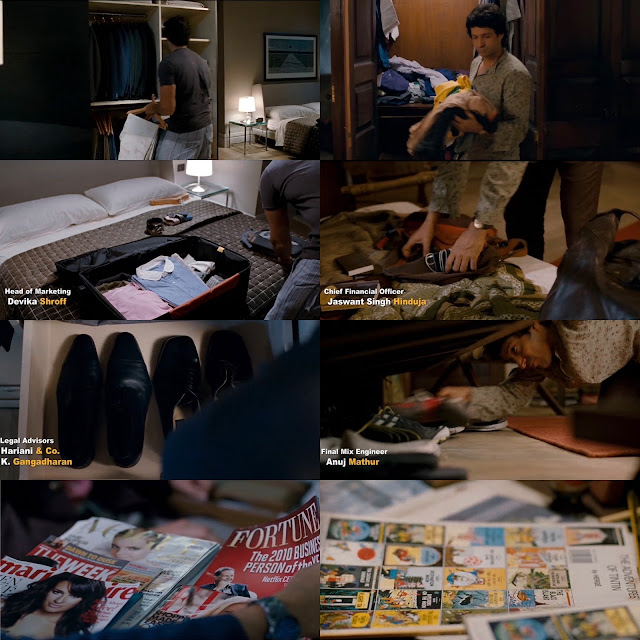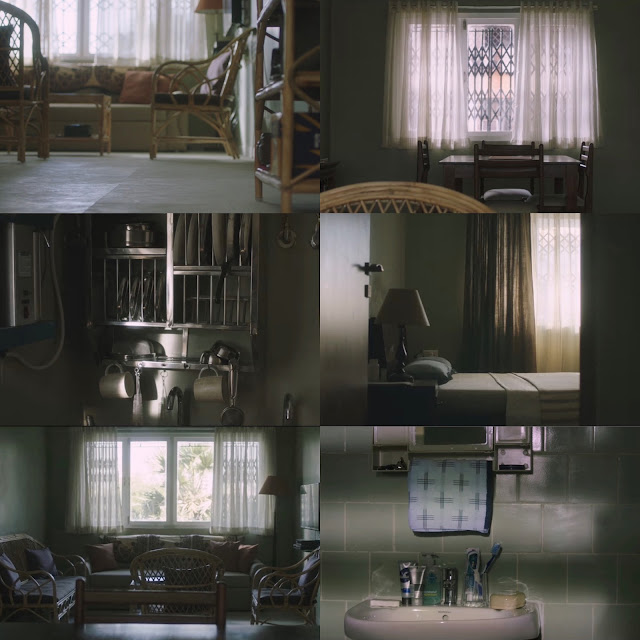Zoya Akhtar has received much appreciation for her work. Her films espouse liberal ideas and are told from the perspective of someone who grew up in South Bombay. A noteworthy thing is that all her films are shot splendidly, with a special emphasis on the opening sequence. So, in this post, I elaborate on how she designs the beginning of her films.

Akhtar’s first film, Luck By Chance, told the story of two struggling actors trying to make it big in the film industry. The film opens with a woman named Sona (Konkana Sen Sharma) sitting in the office of Pinky Productions. A small-time producer, Satish Chadhury (Alyy Khan), tries to convince her there is no need for a screen test for her as a filmmaker’s eye is the camera. It is destiny that has brought Sona into his office. Subtly, he asks her to keep meeting him so they get to know each other better. Sona understands his implication and silently agrees. Thus, the first scene in the film depicts the infamous casting couch where actresses are propositioned for sexual favors in return for casting them in film roles. After this moment, one of the most beautiful opening credits in Hindi cinema come to life. The opening montage, filmed on the heartwarming song Yeh Zindagi Bhi, shows the various professions associated with the making of a film, without whom it would never have been made. It is only befitting then that a film on film pays homage to these unsung artists, creators, and supporters, each of whom plays a crucial role in making a film.

Yeh Zindagi Bhi opens with a man wearing a ‘Crew’ shirt breaking a coconut as it happens in the mahurat of films. Then, there is a shot of the famous Maganlal Dresswala office, a noted costume provider for Hindi films based in Mumbai. A replica of Madhubala’s dress from Mughal-E-Azam and Madhuri Dixit’s iconic purple saree from Hum Aapke Hain Koun..! can also be seen in the frame. Maganlal Dresswala is known for its period costumes in many films, including Mughal-E-Azam, and the mythological series Ramayan and Mahabharat. In 2012, Dresswala, a documentary film directed by Shriya Pilgaonkar and Siddharth Joglekar, traced the rise of Maganlal Dresswala. The four-minute documentary had an interview with one of Masterjis, who also appears in Yeh Zindagi Bhi briefly towards the end.



Then after the costumes, a woman dressed as a fairy stands in front of a toilet, whom Akhtar calls her favorite moment from the credits. Thereafter, we see poster artists, police inspectors, security guards, make-up artists, costume designers, set designers, producers, cameramen, spot boys, cooks, choreographers, special-effect artists, supporting actors, cinema ticket sellers, film projectionists, sound recordists, caterers, and background singers. The people who played the same role in Luck By Chance are mentioned with them. There is also a shot of the bound script with a cup of tea lying on it as a riposte to the time when films only existed in the director’s head. At another point, an usher is shown who is standing in a theater that is playing Farah Khan’s Main Hoon Na. Khan, who is Akhtar’s cousin, also paid homage to those who worked in Main Hoon Naa in its ending credits. Yeh Zindagi Bhi ends with a shot outside a theater called Kismet Talkies which was one of the possible titles of the film. Its lyrics also beautifully surmise the film’s theme. Don’t complain if you stumble anywhere, as your dreams might break while chasing them.
Jo palko ke tale,
Hai apne sapne leke chale,
Hai kehdo woh chale sambhal ke,
Na karna koi gile,
Kahin jo thokar aaisi lage,
Ke sapne tute aansu chhalke.

The opening montage is moving because it comes from a place of genuine love for the film. One of my favorite moments from it is the one when a lady helps an actor wear a saree. We don’t see the actor; instead, we see the smile on the face of the lady. These are the people whose names are mentioned in the opening and the ending credits, but we skip reading about them. Netflix allows viewers to ‘Skip Intro’ at the beginning or immediately takes them to the next episode. Even the Academy Awards decided not to televise awards for technical categories live. In the age of binge-watching, watching credits is a form of rebellion.

Akhtar’s second film, Zindagi Na Milegi Dobara, told the story of three friends who traveled to Spain. The three friends—Arjun (Hrithik Roshan), Imran (Farhan Akhtar), and Kabir (Abhay Deol)—call themselves the three musketeers. The opening song of the film, titled Dil Dhadakne Do, shows them getting ready for the flight to Barcelona. This sequence is the perfect example of the ‘Show, Don’t Tell’—a technique writers use to let the audience experience the story through actions, words, and subtext rather than exposition. The song contrasts the characters of the three friends, especially Arjun and Imran, and we learn more about them by observing their actions. How they pack for their trip brings out the difference in their characters. Arjun is clinical and methodical. His clothes are neatly lined in the closet, and he takes them and puts them in a suitcase. Imran is chaotic and casual. He simply grabs him and shoves them in his bag. Arjun puts all his documents in the folder. Imran packs his diaries and headphones but forgets his passport. Arjun wears formal shoes. Imran wears sports shoes. Arjun rolls his ties perfectly. Imran simply rolls his shirt. Arjun’s room has all the coffee tables and books. Imran’s room has comics. In the airplane, Arjun travels business class. He takes out his laptop and reads a business magazine. Imran travels economy. He flirts with the air hostess. These differences provide more insight into their character rather than any exposition. Even the color palette of their rooms tells us more about Arjun (black) and Imran (colorful). In this montage, Kabir is also present, either thinking, playing video games, or sleeping, but it is primarily Arjun and Imran who are the focus of the song because, as we soon find out, they have some conflict going on. The song ends with them reaching Barcelona, and the audience gets to tour the city while they travel to their hotel.

In her next film, Dil Dhadakne Do, Akhtar told the story of a dysfunctional upper-class family living in Delhi. Unlike Zindagi Na Milegi Dobara, the opening of this film is the opposite of ‘Show, Don’t Tell.’ It uses the family dog Pluto (voiced by Aamir Khan) as the narrator to give a background of the characters. There is also an opening montage that involves animals and humans. The scenes of animals are in black and white, while those of humans are both black and white and colored. The commentary is about how humans have defined their (arbitrary) concept of time. There are shots of people celebrating their birthdays and wedding ceremonies. Then, the commentary segues into the life of the Mehras, providing details about their current family situation. The exposition-heavy opening effectively sets the story’s context, but the pop-philosophical dialogue seems a bit preachy. Perhaps, that is why the opening is not as memorable as her other films.

In Gully Boy, Akhtar brought to life the rags-to-riches story of a rap singer Murad (Ranveer Singh), originating from the slums of Mumbai. Here again, the opening is splendid. It does not have a montage (the montage, in fact, appears in another song Doori). The opening sequence has two different strands. Both these opening strands try to deceive the audience or challenge them somehow. The film’s first shot is not of the hero Murad, as typically happens in many films; instead, the first shot is of Murad’s friend Moeen (Vijay Verma). Moeen takes a long walk in the city at night. He signals Murad and another friend, who are standing at the roadside. The two follow him from behind, and Moeen leads them to eventually steal a car. In this sequence, Moeen emerges as the ‘hero,’ while Murad is only a supporting actor. However, he would soon become the ‘Gully Boy.’ Then, there is the second opening, where Murad’s girlfriend, Safeena (Alia Bhatt), is introduced. The setting is that Murad is on a bus, sitting towards the end while listening to music. Then, Safeena and her mother (Sheeba Chaddha) enter the same bus. There is any seat available for Safeena, so she stands. She looks around and then sees Murad sitting. Their eyes meet. There is a palpable sexual tension in how they glance at each other. It appears they are meeting each other for the first time. But then her mother gets down, and Safeena goes and sits next to Murad. She takes one of his earphones and puts it in her ear. Then, it becomes clear to us that they have known each other before. This is not their first meeting at all. Film critic Rahul Desai beautifully explains more about them in For the “love” of Gully Boy where he writes, “We don’t see them fall for each other or “begin”– a mid-love template hinted at in their first scene, where one is led to believe they don’t know each other until they hold hands. They are childhood sweethearts, already nine years together when the film begins.”

Gully Boy

Doori in Gully Boy
Shades of this ‘middle template’ were also seen in Zindagi Na Milegi Dobara. The film has a ten-minute opening sequence just before the song Dil Dhadakne Do. It starts with Kabir proposing to his girlfriend Natasha (Kalki Koechlin). It appears this is the start of the wedding celebrations and forms the basis of the film’s story, where the three friends decide to go on a trip. Then, towards the film’s end, this same sequence is repeated again, making it clear that the proposal was part of some misunderstanding between the two. Kabir got the ring for his mother on her birthday, but Natasha assumed it was for her. The overarching point here is that the beginning of this film was part of the middle here, like in Gully Boy.

Akhtar’s filmography includes three short films—Bombay Talkies, Lust Stories, and Ghost Stories—and one web series, Made In Heaven. All the aforementioned have a similar touch in their opening sequences. In Bombay Talkies, there is a lovely opening montage, this time with kids, where each describes what they would like to become in life. The kids talk about becoming lawyers, tennis players, businessmen, Spiderman, and football players. This sets the context for the film as it is about a boy forced to play football by his father while he enjoys dancing. Her short film in Lust Stories tells the story of a domestic helper Sudha (Bhumi Pednekar), who is in a sexual relationship with her employer Ajit (Neil Bhoopalam). The film opens with the two of them having sex. Then we see a montage of some beautiful still-life photography of the apartment. In Ghost Stories, a film about the horrors of old age and loneliness, the opening scene is eerie, with the crows cawing over the lead protagonist Sameera (Janhvi Kapoor). A dead crow pops up, portending the film’s end. In the web series Made In Heaven, there is again a lovely opening sequence that comprises real-life wedding shots of ordinary people. It is again nicely done.

Bombay Talkies

Lust Stories

Ghost Stories
The beginning of any film is integral to introducing the audience to its world and allows the filmmaker to establish its tone and character. Writer and director Greta Gerwig said, “Getting the opening just right was so important. When I had it, I thought, ‘There’s a movie here.’ I knew I could make that movie.” Zoya Akhtar’s filmography depicts that she would likely agree with her peer.

Made In Heaven
[Read more of the author’s work on his blog here]





